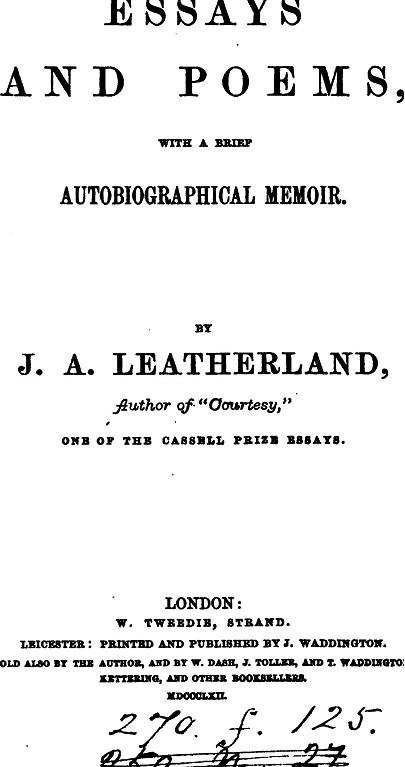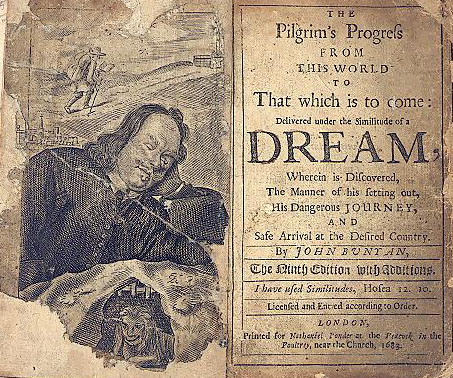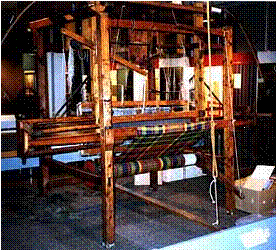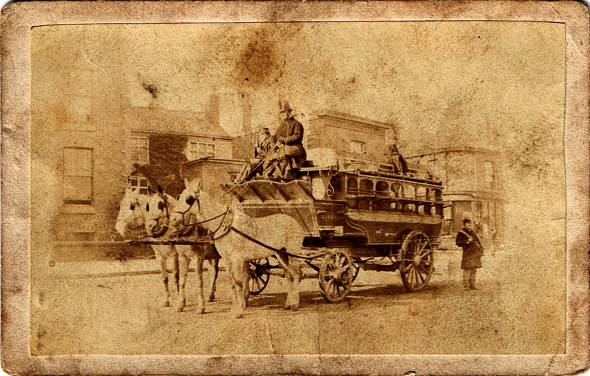John Ayre Leatherland of Kettering : Writer and Poet
John Ayre Leatherland is a fascinating character. We know more about him than most people on this website because he became a writer and wrote a brief autobiography at the age of 50.

I first became aware of him when I was a history undergraduate at the University of York when I came across a book called "Bread, Knowledge and Freedom" by David Vincent. Dr Vincent - who also graduated from York - made a study of nineteenth-century working - class autobiographies. One of the works he looked at was J.A. Leatherland's autobiographical memoir "Essays and Poems with a brief autobiographical memoir" published in London in 1862. I have drawn heavily on his memoir in my account of his life, supplemented by other evidence where possible. Born in Kettering, Northants in 1812, John was the son of Samuel and Hannah Leatherland who married in Kettering Baptist Church. His middle name came from his mother's maiden name, Ayre. His father was a carpenter who died when he was six years old. His mother was the daughter of a baptist minister.

John went to a dame school. He was also schooled by his mother. Dame schools were small privately run schools usually run by an elderly woman in their own home, which helped to educate working class children by teaching reading and writing and maybe a few basic skills. Much of John's education seems to have come from his mother. He he remembered her reading poetry and other literature to him as a boy. His memoirs tell of being passionately fond of books : "whenever I had a spare coin, off I used to run to the bookseller's shop for the tale of "Mother Hubbard, "Goody Twoshoes" "Little Red Riding Hood", and such like lore". He tells the story of having bought a penny book only for a gust of wind to blow it out of his hand and into the damp street. "Whilst I was weeping over its soiled pages, a gentleman passed me and after enquiring what was the matter, gave me a sixpenny piece, telling me to dry up my tears and buy a better." So John went off and bought a topographical work "Thirty-two Remarkable Places of Old England". But it was Bunyan's Pilgrim's Progress which made the greatest boyhood impression on John : "This book it was that early awakened my imaginative powers". John's literary side was also inspired by the Bible "I was also much struck by many parts of the Bible".

(19th century Jacquard ribbon loom - photo from http://www.hollandfamilyhistory.co.uk)
In 1829 at the age of 17 John became an apprentice ribbon weaver. Unfortunately, in his words "this was quite a mistake on the part of my parents". He gave three reasons for disliking the work : (a) his master only made plain goods so he never had the chance to learn more than basic weaving (b) he had to compete with female workers which meant that his earnings were "very small" (c) "the factory was filled with the most ignorant and dissolute characters - tramps and immoral persons" . He described the worshop as "a hot-bed of vice and immorality" ! Despite these difficulties he served out his five year apprenticeship and continued working for the ribbon master for a further three years. He then learned velvet weaving working in a room with seven other young men. He found this much more conducive - "it was like escaping from captivity to liberty - from Pandemonium to Paradise!" - and his new workmates were much more interesting and intelligent. They clubbed together to buy books and formed a self-help "mutual instruction society ". He began to meet the local intelligentsia and read more and more widely. It's interesting to note that he rarely bought books ("up to forty years old I never had half-a-dozen books"). Instead he would borrow books and read from the libraries of his new literary - minded friends.
John married Elizabeth Goode when he was 30 years old - although perhaps oddly he makes scarcely any reference to this in his memoirs. The marriage certificate describes her as a wool spinner. John's writing career seems to have begun whilst he was a velvet weaver. A cousin of his was a baptist minister who started a manuscript magazine to which he frequently contributed. In 1838 he won a local essay writing competition for the two best essays on the "Best Means of Improving the Condition of the Working Classes". John won first prize and a colleague at work won the second prize.

JA Leatherland became involved in the local Chartist movement, becoming Secretary of the Kettering Chartist Association for four years, although his memoirs make it clear that he later greatly regretted this calling it "the bane of my youth" which "pierced me through with many sorrows". He disliked the extremist side of Chartism - "the madman, O'Connor and the fire-brand Stevens" - and became disenchanted with the movement, although I do wonder whether his disparaging remarks about Chartism where with the hindsight of old age.

(Image from a Lancashire carte-de-visite found on www.photo-sleuth.blogspot.com/2008/08/ - an interesting site about old photographs, photographers and their subjects)
The velvet weaving trade declined in the late 1840s and John became unemployed in the winter of 1846-47. He tried to return to ribbon weaving but again found his fellow workers unconducive -"the same reckless dissipation, coarse conversation, and wanton or brutal conduct, prevailed". For a time he became a silk manufacturer with his wife's help and would travel the towns and villages of Northamptonshire selling silk vests. But one day while riding the Northampton and Kettering omnibus, he was seriously injured when it crashed. [This would of course have been a horse drawn omnibus, as the motor vehicle had yet to be invented]. He lost the use of his legs for three weeks, was bedridden for three months, and was in such pain that he thought he was going to die.
After many months he made a recovery but, incapable of manual labour, he used his writing talents to become a reporter for the Northampton Herald newspaper in 1849. He also contibuted to other local newspapers, although he makes little further mention of his journalistic career in the memoirs. The 1861 census describes him as a "reporter and accountant", and the 1871 census "a newspaper correspondent and reporter". There is a reference to him becoming owner of the Wellingborough News in a book review of Chartist writers. The Post Office Directory in 1869 lists him as a reporter.
As well as his "Essays and Poems with a brief autobiographical memoir", J.A. Leatherland also wrote "Psyche : a prize essay on the immortality of the mind and the immorality of the soul etc", a 23 page booklet published by J Butterfield in Northampton (1853).
(There is evidence in "The Collected Works of John Stuart Mill", the philosopher (Volume XVI - The Later Letters of John Stuart Mill 1849-1873) of JA Leatherland having written to John Stuart Mill in 1866 to praise his writings but also to "plug" his own volume of essays and poems. In reply Mr Mill says : "I beg to apologize for the delay in answering your note. I am greatly honoured by the opinion you express of my writings, and had I the necessary leisure, should be happy to read your volume of poems, as you wish me to do so. My time however is so much occupied that I am obliged to defer looking at much that is sent me in those departments of literature to which I give most attention and I fear therefore it will be impossible for me to give the attention to your poems which you wish." In other words : I get many fan letters and books sent to me and I don't have time to read them all !) At the time Leatherland wrote to him, JS Mill was an MP.
John is quite likely to have links with my ancestors as he lived in Northamptonshire. I have not established a firm link, but his baptism records show that his father was Samuel. The best match is with a Samuel Leatherland who was baptised in Welford in 1784 and whose parents (William and Ann) are ancestors of mine from Crick. So - pending further research - my hunch is that J.A. Leatherland may be one of my distant ancestors.
John and his wife Elizabeth had one child, a daughter, Anne, who became a dressmaker. Anne married Henry Staines, a foreman in a shoe factory who later became a commercial traveller. They remained living in Kettering and had one daughter, Lizzie.